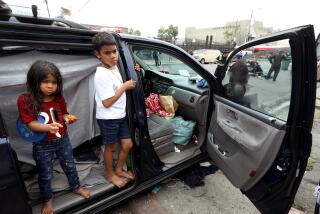Homeless Tell of Need for Job Skills, Programs : Poverty: Unique poll has some surprises. Street people most want training and aid for women, not handouts.
- Share via
In what is believed to be the nation’s first systematic “homeless poll,” a Gallup Organization survey of Skid Row has found that--more than affordable housing or free food--Los Angeles’ street people most want job training, women’s programs and treatment for substance abuse.
The survey, commissioned by the Los Angeles Mission and scheduled to be released today, underscored Skid Row’s reputation as a magnet for chronically homeless, mostly African-American, men. Seventy percent of the respondents were black and 72% were men.
But the poll also challenged widespread assumptions about the city’s neediest population, and was heralded as groundbreaking by opinion researchers, who historically have dismissed the homeless as too elusive, transient and inarticulate to be scientifically sampled.
“To the best of our knowledge, this is a population that has gone largely unmeasured by survey research,” said John Barry, associate director of the Roper Center, the nation’s largest clearinghouse for opinion research. “We’ve seen surveys of low-income families and the unemployed, but as far as we can tell, this is a first.”
The Rev. Mark Holsinger, executive director of the Los Angeles Mission, said the study was also useful from a social service standpoint, and was commissioned to give the mission a set of practical guidelines for its operations.
“A lot of people have the wrong idea about the homeless. They want to come downtown and give them a sandwich. But that’s not what they need,” Holsinger said. “I’ve been doing this for 27 years, and even I was surprised.”
Based on methodology that was developed to enumerate the homeless for the 1990 census, the poll asked the opinions of 665 men and women living between Main Street and Central Avenue, and between 4th and 6th streets downtown--a 24-block area that has for years been among the city’s most desperate and voiceless quarters.
Thick with panhandlers and rife with petty crime, the sector and its ragged residents are often seen as marginal and extreme. But much about the group and its opinions was mainstream.
For example, a quarter of the homeless people sampled had some college education--roughly the same proportion as in the general population in Los Angeles County. Spiritually, the group also mirrored society as a whole: 96% said they believe in God.
Nor did the data buttress the view that the homeless are out to take advantage of taxpayers. Three out of five said they received no welfare, Social Security or other government assistance. And when an open-ended question was posed asking the biggest reasons behind their homelessness, the most common response was alcohol and drugs, followed by or coupled with economic factors such as joblessness.
However, a little more than half the respondents believed that there were too few programs to help the homeless--and the call for aid was especially pronounced among the 182 homeless women surveyed.
Among the women, 67% said the network of homeless programs is inadequate for their needs, despite the inauguration this year by the Los Angeles Mission of a long-term women’s shelter downtown.
Forty-one percent of the female respondents--and 16% of the respondents overall--called for more women’s beds and women’s health programs. Only job training, which was volunteered by one respondent in five, was higher on the Skid Row wish list. Third were drug and alcohol treatment programs, which were called for by 10% of respondents.
Six percent of the respondents overall said they would like to see more shelters or housing programs for the homeless, and 4% called for more soup lines and food banks.
But perhaps the biggest surprise was the ease pollsters had in surveying a subculture that has traditionally been among the most elusive and difficult to reach.
“I was amazed at how responsive they were,” said Gallup senior analyst Elaine Christiansen, who directed the $40,000 survey.
“We sometimes characterize the homeless as a population that doesn’t have well-thought-out views, but they clearly do. As word spread through the community that this was going on, we had people actually waiting to be next in line to be interviewed.”
Christiansen said researchers consulted with homeless people who were enrolled in the Mission’s rehabilitation programs in designing their approach to the project.
In September, after an eight-month planning period, bilingual interviewers were dispatched with instructions to walk counterclockwise around each block, interviewing people until they had either completely covered the block or done 25 interviews.
For safety, she said, each interviewer was accompanied by an escort from the Mission, which is on East 5th Street. The escorts, she added, also gave them an entree that allowed them enough interviews to make a representative sample in 3 1/2 days--far less than the weeks Christiansen had expected that it would take.
More to Read
Sign up for Essential California
The most important California stories and recommendations in your inbox every morning.
You may occasionally receive promotional content from the Los Angeles Times.






